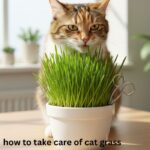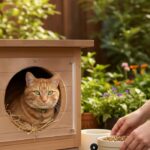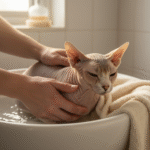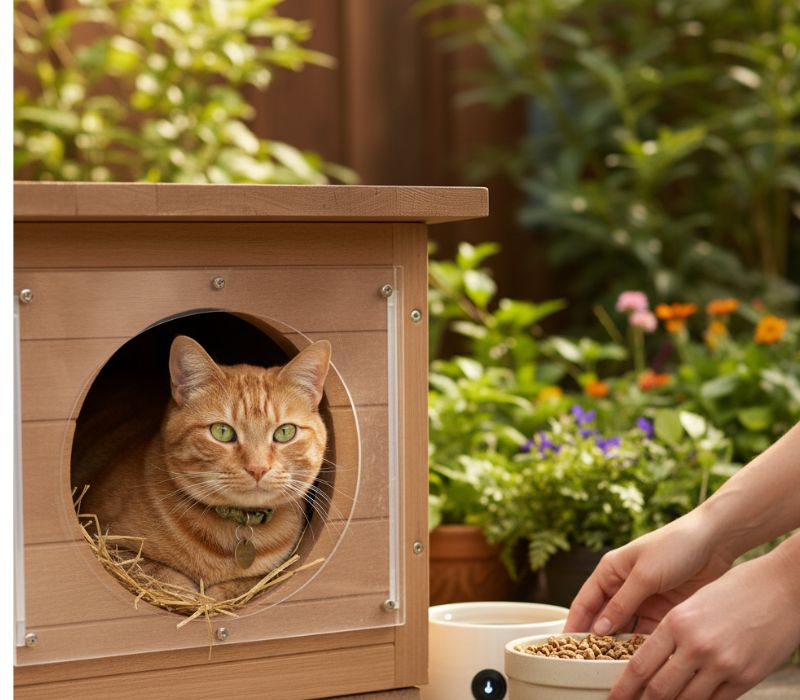Master how to take care of cat grass with this comprehensive guide, covering everything from choosing the best seeds and soil to perfect watering, trimming, and safe feeding practices for a healthy, long-lasting green treat for your cat.
Cultivating Your Cat’s Indoor Oasis
As devoted cat parents, we constantly seek ways to enrich our feline companions’ lives, often overlooking one of nature’s simplest yet most beneficial gifts: cat grass. This isn’t just an ornamental plant; it’s a vital, digestive aid and a source of natural fun for indoor cats. However, merely buying a tray of cat grass isn’t the final step; the real challenge lies in keeping it vibrant and healthy—a task that requires understanding the specifics of its unique needs. If you’ve ever wondered why your cat grass quickly wilts, molds, or simply refuses to thrive, you are about to discover the complete, detailed blueprint for success.
Learning how to take care of cat grass is a straightforward endeavor when you break it down into manageable steps. Forget the misconception that it’s a fickle, short-lived plant. By applying meticulous care techniques, you transform this simple greenery into a robust, long-lasting, and essential part of your cat’s environment. We will meticulously unpack the entire lifecycle of your cat grass, from the foundational choice of seed and soil to the daily routines of watering and lighting, ensuring your cat always has access to the freshest, safest greens. Are you ready to cultivate a perpetually lush, green snack bar for your favorite feline? Let’s delve into the detailed regimen that shows you precisely how to take care of cat grass like a seasoned expert.
Establishing the Perfect Foundation—The First Step in How to Take Care of Cat Grass
Before a single sprout emerges, the success of your cat grass depends entirely on the quality of your initial setup. You cannot simply sprinkle seeds on any old dirt and expect a flourishing, safe plant. This foundational phase is crucial for robust, long-term growth.
Choose Quality Seeds: The Cornerstone of Your Cat Grass Garden
The first, most essential step in learning how to take care of cat grass is selecting the right seeds. Not all seeds are created equal, particularly when destined for your pet’s stomach.
- Prioritize Pet-Safe, Organic Varieties: Always opt for organic, pet-safe seeds to eliminate the risk of introducing harmful pesticides, herbicides, or synthetic fertilizers into your cat’s diet. Common, suitable varieties include wheatgrass (the most popular), barley, oat, or rye. Each offers slightly different textures and nutrient profiles, but all are safe and desirable for cats.
- Understand Seed Lifespan: Recognize that older seeds have a significantly lower germination rate. Purchase from reputable suppliers who specialize in gardening or pet supplies, ensuring you are using the freshest possible stock for a dense, speedy grow-in. A successful germination process is the non-negotiable prerequisite to learning how to take care of cat grass in its mature state.
- Consider a Mix: For added nutritional variety and texture, try a blend of seeds. Oats, for example, tend to grow quickly and have a tender texture, while wheatgrass is robust and packed with vitamins. Offering this blend can make the grass more appealing to a picky cat.
Use Proper Soil: Fueling Healthy Cat Grass Growth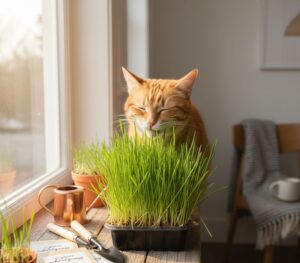
The growing medium provides the necessary nutrients and structure, fundamentally dictating the health of the root system. Overlooking this step jeopardizes the entire plant’s future.
- Select a Chemical-Free Potting Mix: Steer clear of garden soil, which can be dense and often harbors bacteria or weed seeds. Instead, select a well-draining, chemical-free potting mix. Look specifically for products labeled as “organic” or “seed starting mix.”
- The Importance of Drainage and Aeration: The soil must facilitate excellent drainage. If the soil retains too much water, the roots will struggle to breathe, leading inevitably to root rot—the number one killer of indoor plants. Mix in a small amount of perlite or vermiculite if your potting mix seems too heavy. This creates essential air pockets and ensures the roots of your cat grass remain healthy, a primary tenet of how to take care of cat grass.
- Avoid Fertilizers: Your seeds contain enough initial nutrients for the grass to sprout and reach a useful size. Introducing synthetic fertilizers is unnecessary and potentially harmful to your cat. Stick to the pure, clean potting mix.
Provide Good Drainage: Preventing Root Rot and Mold
Drainage is non-negotiable; it separates a short-lived, struggling plant from a robust, enduring one. This point cannot be stressed enough when considering how to take care of cat grass indoors.
- Ensure the Pot Has Drainage Holes: This seems obvious, yet many indoor planters lack this critical feature. Ensure the pot has drainage holes at the bottom. These holes allow excess water to escape immediately after watering, preventing the soil from becoming waterlogged.
- Use a Catch Tray Correctly: While a catch tray is necessary to protect your furniture, do not let the pot sit in standing water. After watering, allow the pot to drain fully for about 15–20 minutes, then empty the catch tray. Allowing the roots to soak indefinitely is the fastest way to invite mold and root rot, completely sabotaging your attempts at mastering how to take care of cat grass.
Nurturing Optimal Growth—The Daily Routine for How to Take Care of Cat Grass
Once planted, your cat grass requires consistent, mindful attention to light and water—the two life forces that ensure a lush, green yield.
Water Correctly: Finding the Perfect Moisture Balance
Inconsistent or excessive watering is the most common mistake cat owners make, leading directly to plant failure. The delicate balance of moisture is central to learning how to take care of cat grass.
- Keep the Soil Moist, Not Soggy: The rule of thumb is simple: Keep the soil moist but not soggy. Think of a wrung-out sponge, not a swamp. Overwatering displaces oxygen in the soil, suffocating the roots and, perhaps more immediately, creating the perfect environment for mold and fungal growth.
- Test the Soil: Use your finger to test the soil depth. If the top half-inch feels dry, it is time to water. If it feels wet, wait another day. Use a gentle stream of water or a spray bottle to avoid displacing the tiny seeds or young shoots. Watering from the bottom (placing the pot in a shallow dish of water for 15 minutes) can also encourage deeper root growth.
- Monitor Humidity: Indoor heating and air conditioning can dry out the soil faster than you realize. A daily check is better than adhering to a strict weekly schedule. Your diligence in maintaining this moisture balance is key to successful how to take care of cat grass.
Give Adequate Sunlight: Fueling Photosynthesis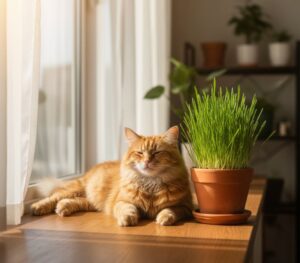
Light is the energy source for all plants, and while cat grass is not a sun-worshipper like a cactus, it needs consistent, gentle light to thrive.
- Aim for Indirect Sunlight: Place cat grass in indirect sunlight for 4–6 hours a day. A sunny windowsill that receives a few hours of direct morning sun, followed by bright, indirect light for the rest of the day, is ideal. Direct, scorching afternoon sun can quickly dry out the tender blades and the shallow root system, leading to wilting and browning.
- Rotate the Pot: Cat grass will naturally grow toward the light source. To ensure uniform, upright growth, rotate the pot a quarter turn every few days. This simple action prevents the grass from leaning dramatically and maximizes the surface area for photosynthesis, an essential trick in the book of how to take care of cat grass.
- Supplementation if Needed: If your home is particularly dark, you can supplement with a simple fluorescent grow light or a desk lamp with a daylight-spectrum bulb. Place it about a foot above the grass for consistent illumination.
Maintenance and Longevity—Sustaining Your Cat Grass Investment
The proactive steps you take after the grass has fully sprouted are what determine its longevity and continuous appeal to your cat. Consistent maintenance transforms a temporary snack into a reliable source of green nutrition.
Trim Regularly: Encouraging New and Healthy Growth
Many owners forget that cat grass needs a haircut, too! Trimming is a fundamental part of the long-term strategy for how to take care of cat grass.
- Cut to Encourage Vigor: Once the grass reaches approximately 6 inches in height, cut the grass to about 3–4 inches using clean, sharp scissors. This practice mimics a grazing animal and forces the plant to divert energy back into the root system, prompting new, tender growth from the base.
- Prevent Wilting and Matting: Trimming prevents the blades from becoming overly long and tough, which makes them less palatable for your cat. It also prevents the grass from naturally wilting and yellowing at the tips due to the plant reaching its natural height limit. Regular trimming is the secret to extending the useful life of your cat grass and truly mastering how to take care of cat grass.
- Handle with Care: Always cut above the soil line. Pulling or ripping the blades can damage the entire root structure, causing significant stress to the plant.
Avoid Mold Growth: Maintaining a Clean, Aerated Environment
Mold is not just unsightly; it can be dangerous if ingested by your cat and is a clear indicator that something is fundamentally wrong with your care routine.
- Ensure Excellent Airflow: Mold thrives in stagnant, humid environments. Allow airflow around the pot by placing it in an open area rather than tucked away in a corner. If you are growing multiple trays, space them out.
- Eliminate Standing Water: As mentioned in the drainage section, don’t let water sit at the bottom of the catch tray. That standing water is a perfect breeding ground for mold spores that can travel up into the soil. Use the bottom-watering technique sparingly, or simply top-water lightly and ensure immediate drainage. This is a critical factor in how to take care of cat grass safely.
- Monitor for White or Gray Patches: If you spot any patches of white or gray fuzz on the soil or lower blades, immediately remove the affected area and consider gently misting the soil surface with a very dilute solution of hydrogen peroxide (1 part peroxide to 10 parts water) to kill remaining spores.
Keep It Clean: Protecting Against Pests and Bacteria
A sanitary environment deters unwanted guests and maintains the overall health of your cat grass.
- Rinse the Container Occasionally: Over time, salt and mineral deposits can build up on the inside of the pot, and the outside can become dusty or sticky. Rinse the container occasionally to prevent the accumulation of bacteria or the attraction of common houseplant pests like fungus gnats, which are drawn to damp soil.
- Inspect Regularly for Pests: Fungus gnats and spider mites are the most common pests. Gently shake the grass over a white sheet of paper; if tiny black dots appear, you have gnats. If you see fine webbing, you have mites. Immediate quarantine and treatment (like neem oil or diatomaceous earth, applied carefully) are necessary to save your grass and demonstrate effective how to take care of cat grass principles.
Lifecycle Management and Safety—When and How to Replenish and Monitor
No cat grass plant lasts forever. Understanding its natural lifespan and incorporating safety monitoring into your routine ensures your cat is always getting the best and safest product.
Regrow When Needed: Embracing the Natural Cycle
Cat grass is an annual plant, meaning it has a finite life. Accepting this and planning for replacement is a hallmark of truly understanding how to take care of cat grass.
- Natural Decline: Cat grass naturally wilts, yellows, and becomes less appealing after about 2–3 weeks of heavy use. Once you see the blades consistently turning yellow or becoming stiff, it is time for a change. Replace or reseed every 2–3 weeks as the grass naturally exhausts its growing cycle and the nutrients in the small container.
- Stagger Planting for Continuous Supply: The best way to manage this lifecycle is by staggering your planting. Start a new batch of seeds every one to two weeks. By the time one tray is beginning to wilt and lose its vigor, the next tray will be 3–4 inches tall and ready for consumption. This clever method ensures your cat never experiences a gap in their fresh green supply.
Monitor Your Cat: Ensuring Safe Consumption
While cat grass is beneficial, moderation is key. You must integrate feline oversight into your understanding of how to take care of cat grass.
- Let Your Cat Nibble Moderately: Cat grass is excellent for digestion and can help your cat pass hairballs. However, let your cat nibble moderately. A little nibbling throughout the day is healthy.
- Watch for Overconsumption: Too much can upset their stomach, leading to vomiting or diarrhea. If you notice your cat consuming large quantities in a single sitting, try moving the grass to a location where access is limited to a few times a day, or simply remove it when they are not actively supervised. The grass is a supplement, not a meal replacement.
Frequently Asked Questions About How to Take Care of Cat Grass
Learning how to take care of cat grass often involves troubleshooting common issues. Here are answers to the most persistent questions.
Why Does My Cat Grass Keep Molding?
Mold is nearly always a result of overwatering and/or poor air circulation. You are essentially creating a humid, stagnant greenhouse effect. What exactly can I do to prevent it? First, reduce the frequency of your watering; remember the “wrung-out sponge” consistency. Second, immediately empty the catch tray after watering, ensuring no standing water remains. Finally, position the pot where it receives a slight breeze or fan movement to keep the surface of the soil dry. Perfecting your watering schedule is a core component of mastering how to take care of cat grass without mold.
How Long Will Cat Grass Last?
Generally, a single tray of cat grass, if cared for diligently, will remain lush and palatable for your cat for 2 to 3 weeks. You can slightly extend this lifespan to about 4 weeks with religious trimming and rotation. Once the blades become tough, yellow, or sparse, its utility diminishes, and replacing it is the best practice. Planning for this short cycle is critical to understanding how to take care of cat grass effectively.
Can I Grow Cat Grass Outdoors?
Yes, you certainly can! Growing it outdoors in a container is an excellent way to provide your cat with fresh greens, but you must ensure two things: First, keep it protected from garden pests and diseases that are more prevalent outdoors. Second, if your cat uses the grass, ensure the container remains within an enclosed, safe space, or bring it inside immediately after they graze to prevent exposure to potential toxins or neighborhood animals.
Is Cat Grass the Same as Catnip?
No, they are entirely different plants with different effects. Catnip (Nepeta cataria) contains nepetalactone, a compound that affects a large percentage of cats, often causing a euphoric or playful response. Cat grass (typically Triticum aestivum or wheatgrass) is a true grass that offers dietary fiber, vitamins, and aids in digestion—it has a purely physical, non-psychoactive benefit. Knowing the difference is key to providing your cat with the intended supplement and improving your skills in how to take care of cat grass correctly.
My Cat Ate Too Much Cat Grass and Vomited—Is This Normal?
It can be a normal, though unpleasant, occurrence. Cat grass is high in fiber and is believed to help cats regurgitate indigestible matter, such as hairballs. Vomiting immediately after eating the grass is often just the result of that process. However, if the vomiting is excessive, contains blood, or is accompanied by other symptoms like lethargy,* seek veterinary advice immediately*. For prevention, simply restrict access to the cat grass, monitoring your cat to ensure they only get to nibble moderately and not gorge themselves.
Conclusion: Sustaining a Green Delight with Cat Grass
Mastering how to take care of cat grass is a rewarding experience that directly benefits the health and happiness of your cat. It’s a process built on attention to detail: starting with the best organic seeds and well-draining soil, maintaining the precise balance of moisture and indirect light, and following up with a regimen of regular trimming and hygiene.
Remember, successful cat grass care is not a one-time task but a continuous cycle of growth, maintenance, and replacement. By implementing these detailed, methodical steps—from preventing mold with good drainage to monitoring your cat’s consumption—you ensure a constant supply of tender, nutritious, and safe greens. You are now equipped not only to grow cat grass but to cultivate a thriving, sustainable, indoor feline garden that your cat will undoubtedly adore. Commit to these principles, and you will see your cat’s favorite natural snack flourish. What subtle sign will tell you it’s time to reseed your next batch of cat grass?




